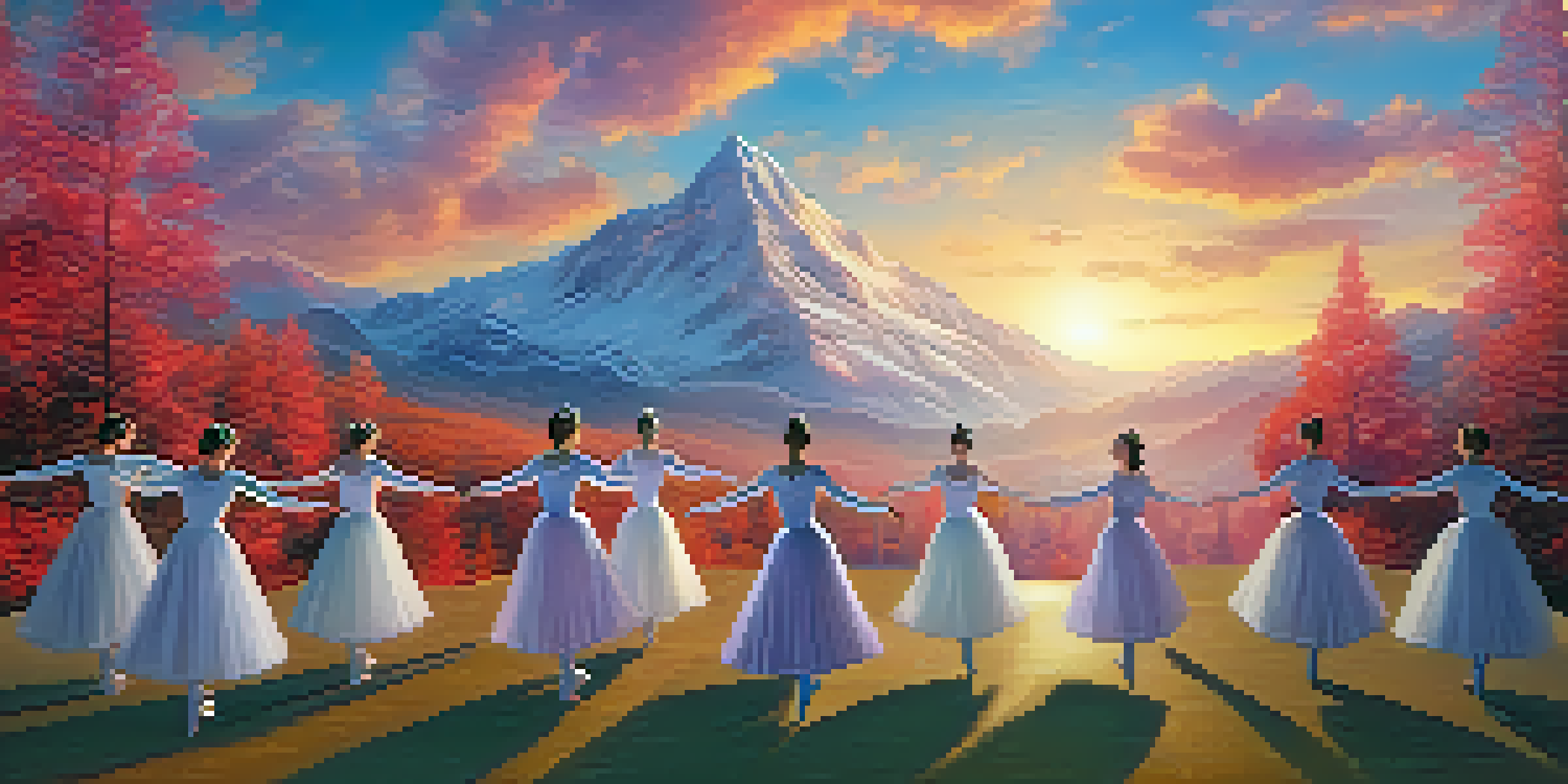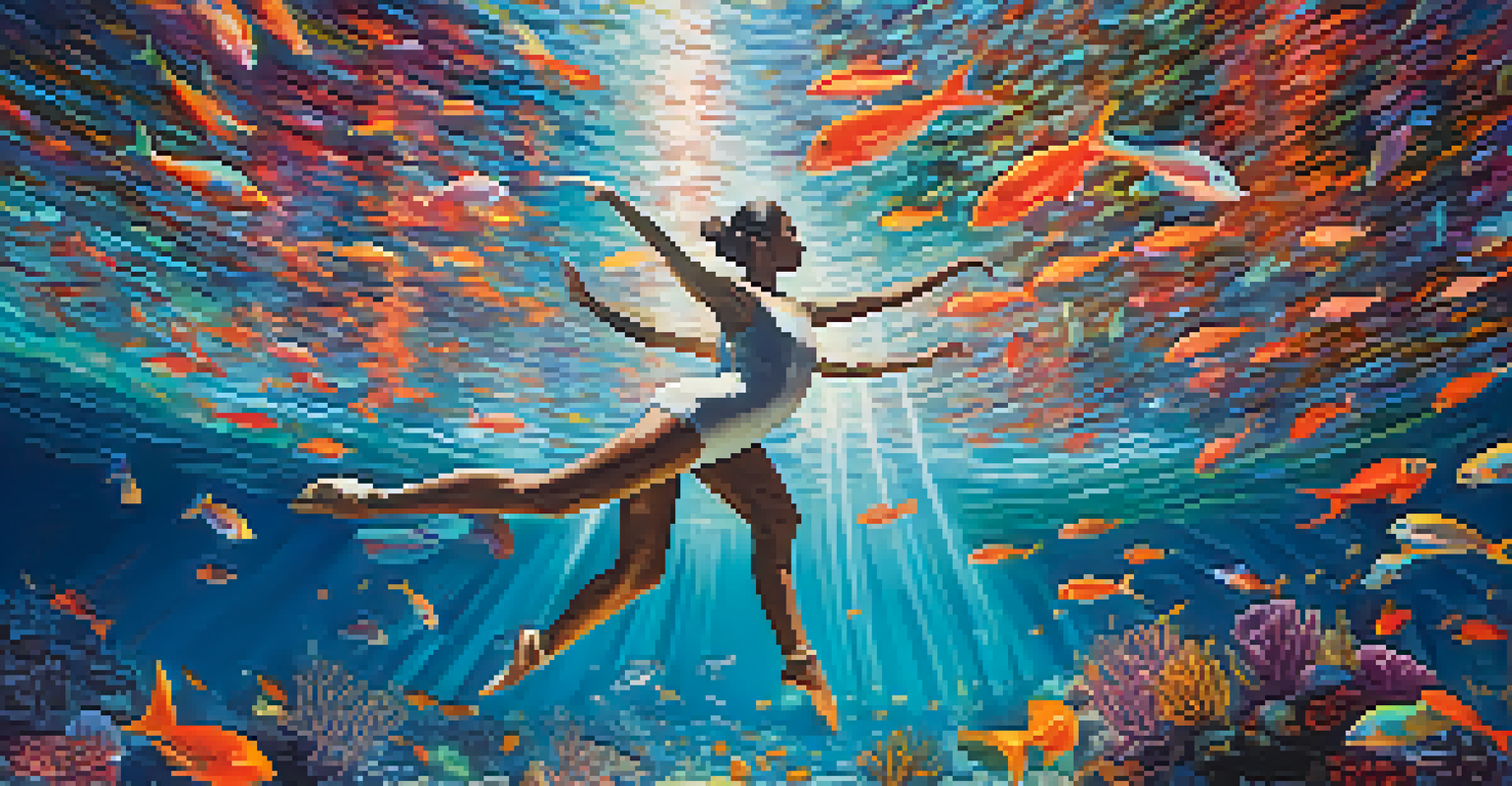Digital Dance: Virtual Reality's Role in Performance Art

The Intersection of Dance and Virtual Reality
Virtual Reality (VR) is revolutionizing the way we experience dance and performance art. By immersing audiences in a digital world, VR allows them to engage with dance in ways that were previously unimaginable. Imagine watching a ballet where you can fly above the dancers, or a contemporary piece where the environment shifts with each movement; this is the magic of VR.
Dance is the hidden language of the soul.
This technology breaks the physical boundaries of traditional theaters, enabling performances in stunning, fantastical settings. For instance, a dancer could perform on a virtual mountain peak or underwater, creating a visual spectacle that complements their movements. Such environments not only enhance the storytelling but also invite viewers to interact with the performance on a deeper level.
Moreover, VR allows choreographers to experiment with new forms of expression. With the ability to manipulate space and perspective, they can create choreography that would be impossible in the physical world. This fusion of technology and art opens up endless possibilities for creativity and innovation in the dance community.
Enhancing Audience Engagement Through Immersion
One of the most exciting aspects of VR in dance is the immersive experience it offers audiences. Unlike traditional performances, where viewers are passive observers, VR invites them to step into the dancer's shoes—quite literally. This level of participation can lead to a more profound emotional connection with the art form.

Imagine donning a VR headset and finding yourself in the middle of a vibrant dance scene. You can look around, see the dancers up close, and even feel as if you are part of the performance. This interactive element grabs the audience's attention and makes them feel like they are integral to the story being told.
VR Transforms Dance Engagement
Virtual Reality creates an immersive experience that allows audiences to actively participate in dance performances, deepening their emotional connection.
In this way, VR not only enhances engagement but also democratizes dance. People who may not have access to live performances can experience the artistry and emotion of dance in their own homes. It invites a broader audience, fostering a love for performance art that transcends geographical boundaries.
Choreography in the Digital Age
As artists embrace the capabilities of VR, choreography is evolving to fit this new medium. Dancers are not just moving through space; they are creating interactions with virtual elements that can change in real-time. This dynamic choreography challenges both the dancers and the audience to rethink movement and space.
The future of dance is in the hands of those who can embrace technology and innovation.
For example, choreographers can design routines that respond to audience actions or adapt based on viewer feedback, making each performance unique. This fluidity contrasts sharply with traditional choreography, where the performance is static and unchanging once set. The idea of a performance that evolves based on interaction adds a thrilling layer of unpredictability.
Additionally, dancers can explore virtual personas, allowing them to push the boundaries of their physical forms. By blending their movements with animated avatars or digital effects, they can showcase a range of emotions and stories that enhance the performance. This innovative approach not only captivates audiences but also expands the dancer's artistic repertoire.
Bridging Cultures and Communities
Digital dance through VR is not just about individual performances; it's also about connecting diverse cultures and communities. Artists from around the world can collaborate in virtual spaces, breaking down barriers and sharing their unique styles. This cross-cultural exchange enriches the art form and introduces audiences to various dance traditions.
For instance, a VR performance could feature a fusion of traditional African dance with modern ballet, showcasing the beauty of different cultural expressions. This blending not only celebrates diversity but also fosters understanding and appreciation among audiences from various backgrounds. Through such collaborations, VR helps to highlight the universal language of dance.
Choreography Evolves with Technology
Choreographers are now able to create dynamic routines that interact with virtual elements, offering unique performances that adapt based on audience feedback.
Moreover, these virtual performances can reach underserved communities, giving them access to world-class art forms that they might not otherwise experience. By making dance more accessible, VR encourages participation and inspires new generations of dancers and choreographers from all walks of life.
The Role of Technology in Dance Education
As VR becomes more integrated into the world of dance, it is also transforming dance education. Students can learn techniques and styles from the comfort of their homes, interacting with virtual instructors and peers. This accessibility can democratize dance education, allowing anyone with a headset to join in, regardless of their location.
Instructors can create immersive lessons where students practice alongside digital avatars, providing instant feedback and corrections. This hands-on approach can enhance learning and help students grasp complex movements that might be difficult to understand through traditional teaching methods. Imagine being able to practice a pirouette with a virtual coach guiding you in real-time.
Furthermore, VR allows students to explore choreography that blends various styles, encouraging creativity and experimentation. This approach nurtures a new generation of dancers who are not only skilled in their craft but also comfortable with technology. The combination of artistry and tech-savviness prepares them for a future in an increasingly digital world.
Challenges and Limitations of VR in Dance
Despite the exciting possibilities that VR brings to dance, there are challenges and limitations to consider. One major concern is the accessibility of the technology itself. Not everyone has access to VR headsets or the necessary hardware, which can create a divide between those who can experience these digital performances and those who cannot.
Additionally, the physical aspect of dance cannot be fully replicated in a virtual environment. While viewers can appreciate the artistry, they may miss the visceral experience of being in a live audience, feeling the energy and emotions of the performers. This gap raises questions about what it means to truly experience dance and whether virtual performances can evoke the same impact as traditional ones.
Digital Dance Bridges Cultures
VR fosters collaboration among diverse artists, allowing them to blend various dance styles and reach underserved communities, enriching the art form.
Moreover, the learning curve associated with VR technology can be a barrier for both artists and audiences. Not everyone is comfortable using VR headsets or navigating digital environments, which can limit participation. Addressing these challenges is crucial to ensuring that the benefits of VR in dance are accessible to a broader audience.
The Future of Digital Dance and Performance Art
Looking ahead, the future of digital dance and performance art seems bright and full of potential. As technology continues to advance, we can expect even more innovative ways to blend dance with virtual reality. Artists will likely explore new narratives and formats that challenge our perceptions of movement and storytelling.
The possibilities for collaboration between dancers, musicians, and visual artists in virtual spaces are endless. Imagine a performance where the music and visuals are dynamically generated based on the dancers' movements, creating a truly immersive experience. This kind of synergy can lead to groundbreaking works of art that redefine the boundaries of performance.

Ultimately, as we embrace digital dance, we may find ourselves at the forefront of a cultural shift. By integrating technology into the art form, we can create new ways of experiencing and appreciating dance, making it relevant for future generations. The evolution of dance through VR is not just a trend; it's a transformation that invites everyone to participate in the beauty of movement.